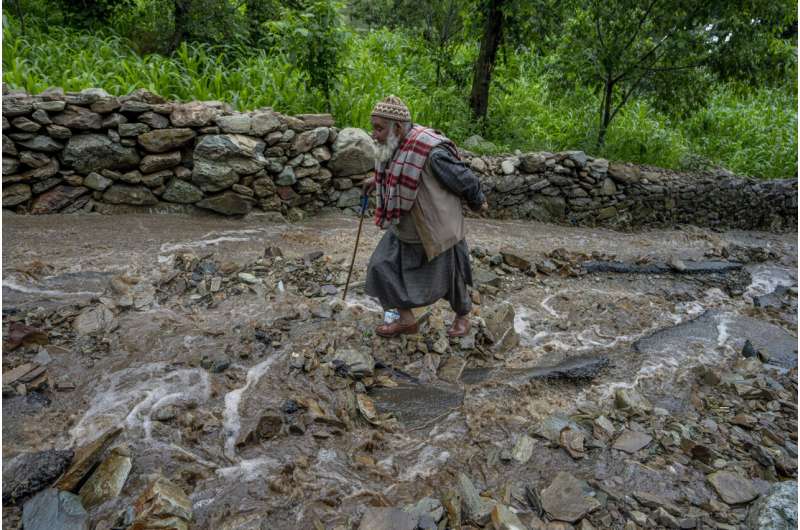This article has been reviewed according to Science X's editorial process and policies. Editors have highlighted the following attributes while ensuring the content's credibility:
fact-checked
reputable news agency
proofread
What are cloudbursts and is climate change making them more frequent?

Last Saturday, Mohammed Aslam was working in his kitchen garden when he heard his fellow villagers shouting that water was coming from the nearby foothills in southern Kulgam area in Indian-controlled Kashmir. Within moments, the farmer said, mud and muck from gushing water swept through the village, damaging scores of homes.
"It was sudden and swift," Aslam said.
A cloudburst followed by flashfloods hit nearly a dozen villages in Kulgam, filling homes with mud and washing away some cattle.
A day before, on Friday night, another cloudburst in the neighboring arid, cold desert region of Ladakh triggered flashfloods and inundated parts of its major town, Leh. The floodwaters entered the town's main market, damaging shops, sweeping away vehicles and leaving its streets a muddy mess.
Intense rainfall in the Himalayan regions of India's Kashmir state and the adjacent mountainous cold desert of Ladakh last week destroyed roads and caused flooding of dozens of villages.
Cloudbursts are a common occurrence in Himalayan regions but experts are alarmed by the increase in extreme weather-related events.
Intense weather events, especially when more than 10 centimeters (3.94 inches) of rainfall occurs within a 10 square kilometers (3.86 square miles) region within an hour, are called cloudbursts. They have the potential to wreak havoc, causing intense flooding and landslides that affect thousands of people in mountainous regions.

Last year, a cloudburst triggered flash floods during an annual Hindu pilgrimage to a Himalayan Mountain cave in southern Kashmir, l eaving at least 16 people dead.
In 2010, dozens of villages and the main town of Leh in Ladakh were hit by the worst floods in its recent history. Homes and farm fields were devastated and over 250 people were killed.
Experts say the frequency of such events has been increasing in recent years partly due to climate change. They say damage caused by cloudbursts is also increasing because of unplanned development in mountain regions.
Cloudbursts are like a "a huge bucket filled with water that is toppled over," said Anand Sharma, a retired meteorologist with the Indian Meteorological Department, the country's weather agency. Born in the Himalayan region, Sharma has closely observed this phenomenon over his three-decade career.

Sharma says cloudbursts occur when cumulonimbus clouds—enormous water-filled, cauliflower-shaped clouds—empty their contents because of cold air pushing the water down. "Normally there are drafts flowing both up and down but in certain conditions, especially when the cloud grows up vertically, sometimes up to 16 kilometers (9.94 miles), cold air enters the cloud and the air flow moves only downwards," he said.
Mukhtar Ahmed, an official at IMD's Kashmir office. said global warming is increasing the frequency of cloudbursts. "We are witnessing flash floods, cloudbursts and unusually high temperatures more often now," he said.
Sharma said "Global warming is leading to more evaporation of water and because of this dense cumulonimbus clouds are forming, resulting in intense rainfall." While some regions receive intense rainfall, he said global warming is resulting in prolonged droughts in other regions.
Experts say excessive deforestation and unplanned developments should be avoided in climate-vulnerable regions such as the Himalayas.
-

Kashmiri villagers walks on a road damaged by flash floods after a cloudburst on the outskirts of Srinagar, Indian controlled Kashmir, July 22, 2023. Such intense rainfall events, especially when more than 10 centimeters (3.94 inches) of rainfall occurs within a 10 square kilometers (3.86 square miles) region within an hour are called cloudbursts and have potential to wreak havoc, causing intense flooding and landslides that affect thousands in mountain regions. Credit: AP Photo/Dar Yasin, File -

Kashmiri men pile rocks and boulders to stop floodwaters from entering their field after a cloudburst on the outskirts of Srinagar, Indian controlled Kashmir, July 22, 2023. Such intense rainfall events, especially when more than 10 centimeters (3.94 inches) of rainfall occurs within a 10 square kilometers (3.86 square miles) region within an hour are called cloudbursts and have potential to wreak havoc, causing intense flooding and landslides that affect thousands in mountain regions. Credit: AP Photo/Dar Yasin, File
"The chances of landslides increase when there is excessive deforestation. Similarly, when there are known flood paths, it is best to avoid any construction in those regions," said Mahesh Palawat a meteorologist with Skymet Weather, a private weather forecaster in India.
"It is important for people living on foothills or slopes to be moved to higher ground when heavy rains are likely to occur to minimize loss of life," Palawat added.
© 2023 The Associated Press. All rights reserved. This material may not be published, broadcast, rewritten or redistributed without permission.





















